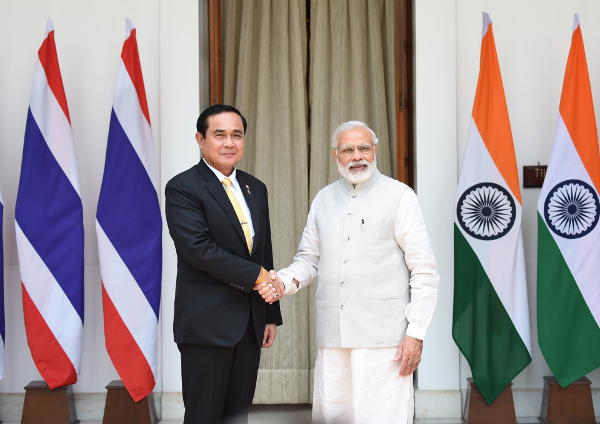Trade relations between India and Thailand, the second-largest economy in the Southeast Asian economic group, ASEAN, has grown by leaps and bounds in the last two years.
Latest statistics published by the Indian Embassy in Bangkok, Thailand, shows that trade has been grown some 60 per cent since 2016.
However, if the timeline is drawn back to 2014, the total growth is down to 44 per cent in 5 years or a less impressive CARG of 7.6 per cent.
This can be attributed to trade decline in 2014 and 2015 due to the uncertainty following the 2014 imposition of martial law in Thailand and which just ended this year.
According to the World Bank, Thailand had a nominal GDP of USD 505 billion in 2018 of which two-thirds are dependent on exports.
Thailand owes its close trade and diplomatic ties with India to historic, cultural and social reasons.
The main religion in Thailand, Buddhism as well as the script used for its language, has Indian roots.
Additionally, fostering strong economic, commercial and cultural links are regular people to people contact and also-complementary economic ideology – India has a “Look East”, “Act East” policy and Thailand its own “Look West”, “Act West” philosophy.
Two-way trade in 2018 totalled USD12.46 billion with USD7.60 billion in Thailand exports to India and USD4.86 billion in Indian exports to Thailand. In ASEAN, Thailand ranks as India’s fifth-largest trading partner after Singapore, Vietnam, Indonesia and Malaysia.
Fourth-place Malaysia’s bilateral trade with India stands at USD 15 billion in 2018 and is expected to be a touch lower in 2019. India’s trade with Thailand is expected to overtake Malaysia in the next two to three years if it continues at the current growth trajectory.
Foreign direct investments (FDI) from Thailand into India has also grown significantly from just USD 11.55 million in 2012 to USD 92.22 million in 2018 (CAGR 34.6 per cent), and with about USD 90 million already committed in the first six months of this year, this is expected to continue to grow strongly. These investments have been mostly in infrastructure, real estate, food processing, chemicals and hospitality.
However, FDI from Thailand to India has been on a steady decline over the years. It was USD 63.45 million in 2014 and USD 13.34 million in 2018.
What is going to boost investment and business opportunities in the coming years is the ASEAN Economic Community (AEC) blueprint 2025. The ultimate aim of the AEC blueprint is to achieve the ASEAN common market with intermediate steps taken to gradually bring greater integration among member countries.
The benefits of this blueprint to countries doing business with ASEAN will be in the form of seamless movement of goods, tariff rationalisation and a more open and predictable investment regime in all ASEAN countries. This makes it possible for Indian companies to access the USD 2.8 trillion ASEAN markets through Thailand.
An ASEAN common market has huge potential for anyone trading with it. Economists predict it to become the fourth-largest economy in the world by 2030 surpassed only by the US, China and the EU.
It is with this in mind that an MOU between the Indian port of Krishnapatnam located in Nellore District of Andhra Pradesh and Ranong Portin the South Western part of Thailand was signed earlier this month.
Under the MOU, a new maritime route will be promoted in the Andaman Sea which will reduce travel time between India and Thailand from 10-15 days to seven. Currently, cargo from Krishnapatnam Port has to travel to Laem Chabang Port in Chon Burior Bangkok Port in Bangkok via Malaysia.
The development of Ranong Port is part of the Thai government’s Southern Economic Corridor (SEC) infrastructure development plan where about USD 3.5 billion will be spent over 4 years. Half of that amount will go to specifically develop the Ranong deep-sea port and airports in 4 provinces.
The SEC is developed with the vision of it becoming the gateway to South Asia. As part of this vision, the Port of Authority of Thailand(PAT) aims to make Ranong Port the logistics gateway between Thailand and India. The capacity of Ranong Port will be increased by six and a half times to reach a capacity of 500,000 TEUs per year by 2022.
Krishnapatnam Port already has this capacity.
The MOU is part of the Thai government’s policy to boost trade with India, Bangladesh and Sri Lanka under the framework of Bay of Bengal Initiative for Multi-Sectoral Technical and Economic Cooperation (Bimstec).
According to PAT director-general Kamolsak Promprayoon, PAT’s 2018 earnings from exports to Bimstec was worth over USD 13.2 billion.
Out of this, USD6.6 billion came from exports to India.
Major exports from Thailand to India include electronics, machinery, automobile and automobile parts and accessories, jewellery, and rubber products. Coming the other way from India are crude oil, chemicals, machinery, jewellery including gold and silver, iron and steel products and food products.
Both Thailand and India have been touted as beneficiaries of the protracted trade war between the US and China. With no sign of this abating any time soon, many businesses are planning to or are already in the process of re-siting their manufacturing facilities to other locations including India, Thailand and Vietnam (which is an ASEAN country).
As this happens, the movement of goods will increase between ASEAN and India and port pairs like Krishnapatnam and Ranongwill almost certainly become busier.
Source: IT
Image Courtesy:Ministry of Foreign Affairs
You may also like
-
IAF Aircraft Set Course For Exercise Eastern Bridge VII At Oman
-
Trade Connect E-platform For Exports Is Single Window, Fast, Accessible And Transformational: Shri Piyush Goyal
-
India-us Working Together In Areas Like Critical Minerals, Supply Chains And Advanced Technologies: Shri Piyush Goyal
-
Dot Simplifies Approval Processes For Telecom Licenses And Wireless Equipment
-
Coal Production and Supply Trends on Positive Trajectory
